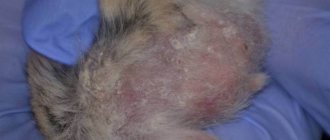Diseases of hamsters - oral cavity and skin
Boils. Hamster diseases
Hamster abscesses are a type of abrasion that appears mainly on the pads of hamsters' feet.
- reasons - the exact cause of the appearance of abscesses has not been found, but veterinarians are inclined to mechanical injuries;
- symptoms - the presence of abrasions on the pet’s paws, which are detected during a visual examination of the hamster;
- treatment - most often, to eliminate abscesses in hamsters, doctors prescribe the use of ointments with zinc or fish oil, or preparations based on these components. Treatment of such a seemingly minor disease can take several months, since the pads are very sensitive and are constantly exposed to stress.
Anomalies of teeth. Hamster diseases
Anomalies of teeth in hamsters - all representatives of rodents have such a feature as the constant growth of their front teeth. Because of this, the animal’s bite may be disrupted and the teeth simply do not close. This already leads to digestive disorders, etc.
- reasons - the cause of such anomalies may be genetic characteristics that imply accelerated tooth growth, or the cause may be a diet that contains very little solid food. The animal simply does not have time to grind down its teeth;
- Diseases of hamsters often spread to the teeth; the most common symptoms of dental pathologies are increased salivation. The pet may refuse food, stop gnawing food;
- treatment - to cure this type of pathology, you should not self-medicate, but seek help from a veterinarian. Often a procedure such as treating teeth with a drill is performed. If “hooks” appear on the teeth as a result of the disease, they should also be removed.
Inflammation of the cheek pouches. Hamster diseases
- reasons - inflammation of the sacs occurs if there is any damage to them on the inside. Also, if food is constantly stored there, an inflammatory process may occur due to the interaction of tissues and fibers of the products;
- symptoms - as a rule, symptoms of inflammation of the cheek pouches may be absent at all. But there may also be a decrease in appetite due to painful sensations;
- treatment - it is possible to fix the inflammation only by contacting a veterinary center, since to examine the cheeks from the inside you need to turn them out correctly. If you do not have the necessary skills, you can cause discomfort to your pet. Inflammation is treated by removing remaining food and treating with bactericidal agents.
Hair loss in hamsters
Baldness in hamsters may be confused by some owners with lichen, since they are very similar upon visual inspection. The only difference
, which can clarify the picture is the presence of scales in areas of hair loss in cases of lichen, while in cases of baldness the skin remains smooth. You should not diagnose yourself; in any case, you should consult a veterinarian.
- reasons - the causes of baldness in hamsters include the following factors: a decrease in the intake of vitamins and minerals in the body, frequent and severe stress in the pet;
- symptoms - symptoms manifest themselves in hair loss, you can also notice apathy and lethargy in your pet;
- treatment - if there is a lack of vitamins, they should be included in the hamster’s diet. If there is stress, it is necessary to exclude its occurrence.
Herpes in hamsters
Herpes in hamsters is an inflammation of the skin near the mucous tissues of the animal.
- reasons - a hamster can become infected with herpes through contact with other hamsters;
- symptoms - the disease occurs without any visible symptoms. It can be detected more often only during routine veterinary examinations;
- treatment - this disease does not require special treatment and goes away on its own in one to two weeks, but in any case, consultation with a specialist is necessary to know exactly what ailment your pet has.
Trichomonosis. Hamster diseases.
Trichomoniasis in hamsters is a disease caused by the activity of a parasite from the Trichomonas gallinae family.
- reasons - the parasite can enter your hamster’s body by drinking dirty water or bad food. Due to weak immunity, young people are especially more susceptible to trichomoniasis than adults;
- symptoms - manifested in a yellowish tint of the pharynx. Subsequently, it increases in size, as if it swells and blocks access to oxygen;
- treatment - carried out through the use of medications that should only be prescribed by a veterinarian. If you do not help your hamster in time, death is possible.
Conjunctivitis in hamsters
Conjunctivitis is also a disease of hamsters; it is a pathology associated with disruption of the mucous membrane of the eyes.
- causes - bacterial infections or colds that cause complications;
- symptoms - there may be copious discharge of mucus from the eyes;
- treatment - doctors recommend rinsing the eye mucosa with salt water or using special drops.
Metabolic disorders
Metabolism is the proper functioning of all body systems. Food processing, energy production, removal of unnecessary and harmful products. The central nervous system is responsible for all this, but the glands that secrete hormones have a huge influence on metabolic processes. These include the thyroid and pancreas, adrenal glands, pituitary gland, and gonads. Poor nutrition, poor environment, and hereditary factors affect the functioning of these organs. Violation of their normal functioning leads to a malfunction of the body as a whole. Diseases of Djungarian hamsters are often associated with metabolic disorders.
Diabetes
may develop due to excessive carbohydrate consumption. Hereditary predisposition to the disease also plays a role. You can find out that a hamster has contracted this disease by the characteristic smell of acetone, which comes from the rodent’s saliva and urine. But only a doctor can make a final diagnosis by doing a blood test. Prevention of disease in Djungarian hamsters is a balanced diet, eliminating sugar from the diet, good care and an active lifestyle.
Stroke
– can also be attributed to diseases arising due to metabolic disorders. With age and as a result of poor nutrition, cholesterol plaques are deposited on the walls of blood vessels, which prevent the normal passage of blood. At some point, the plaques completely block the vessel, it bursts, and hemorrhage occurs.
If your hamster is shaking or having convulsions, the end is probably near.
Sometimes attentive owners are concerned that the rodent has a yellow sore on its stomach. In fact, this is a scent gland, with the help of which the male marks his territory.
Digestive diseases in hamsters
Obesity in hamsters
Obesity in a hamster - an increase in the amount of subcutaneous fat in a hamster can have a bad effect on other organs, such as the heart. By nature, the hamster is a mobile animal and needs constant exercise.
- reasons - a decrease in physical activity, often due to the fault of the owner, when living conditions do not meet the requirements;
- symptoms - a visual increase in the fat layer in the hamster. Decreased overall activity
- treatment - increasing the load, installing various treadmills and attractions in the cage. Monitoring caloric intake.
Colibacillosis. Hamster diseases
Colibacillosis in a hamster is a disease of the gastrointestinal tract, which manifests itself in its disorder. Also, this disease is called “ wet tail ”. It has a bacterial origin. This intestinal pathology can confuse owners
, since in the early stages it is similar to other diseases that are not of a bacterial nature.
- reasons - the presence of unfavorable bacteria in the body, which come from food or water;
- symptoms - the main sign is the presence of diarrhea in a hamster. Subsequently, lack of appetite, water diarrhea, aggressive conditions, bleeding are connected;
- treatment - colibacillosis can be cured only by following all the instructions and recommendations of a veterinarian. Most often, solutions containing electrolytes are used to improve the hydration process. Along with this, antibiotics are prescribed that stabilize the condition of the intestines. It is also necessary to adhere to a certain diet, which involves excluding certain foods from the diet.
Important! Colibacillosis can be transmitted to other individuals. Therefore, if you have other hamsters, they must be isolated from the infected pet.
E. coli is also a disease of hamsters
E. coli in hamsters is a disease that causes significant discomfort to the pet, even death. It is infectious in nature. As the disease progresses, the intestinal flora of the infected hamster changes due to the activity of the microbe.
- reasons - penetration of an animal microbe into the body;
- symptoms - signs of E. coli are a high body temperature in the animal and the presence of bloody diarrhea during bowel movements;
- treatment - the disease in most cases ends in death for the pet. It is very important to fix it in the early stages (which is very difficult, since it develops very quickly), in order to leave at least some chance of recovery.
Enteritis in a hamster
Enteritis in hamsters affects the organs responsible for normal digestion of the animal.
- reasons - doctors call the main factor in the development of enteritis, the lack of hay in the diet;
- symptoms: bloating and diarrhea;
- treatment looks specific. The feces of a healthy animal are taken, mixed in water and administered as an enema to the patient. It is also recommended to include hay in the diet to improve digestion.
Poisoning - diseases of hamsters
- reasons: poor quality of food consumed, presence of household chemicals on food products. Dirty or stagnant water;
- symptoms: loss of appetite, lethargy. Sometimes diarrhea and vomiting;
- treatment - a veterinarian should prescribe treatment based on the results of the examinations. It is important to distinguish poisoning from a viral infection. Failure to seek help in a timely manner can result in death.
Steps
Caring for a sick hamster
- Pay attention to the appearance of signs of illness in the hamster.
If your pet is not behaving as usual, observe him more closely. This may be the first signal that your hamster is getting sick. Answer the questions below.
- Is your hamster sleeping more than usual? Keep in mind that older hamsters tend to sleep longer.
- Has your hamster lost his appetite?
- Has the hamster stopped licking itself?
- Is he irritable?
- Is he lethargic when awake and has difficulty moving around?
- Is the hamster's hair falling out or does it have bald spots? Keep in mind that this is normal for older hamsters.
- Is his chin or neck wet? This may be a sign of dental problems.
- Does he have difficulty eating food, such as food falling out of his mouth?
- Is his nose running, are his eyes watering, and is his butt getting wet?
- Has the appearance of his excrement changed? Your hamster's poop should be rod-shaped. Liquid excrement may indicate an excessive amount of fresh fruits and vegetables being eaten. Too hard and dry excrement indicates insufficient quantity.
- Keep your hamster warm.
You may encounter a situation where your hamster is not feeling well. That being said, there are a number of general steps you can take to help your hamster get better quickly. Make sure your hamster is warm. Sick hamsters often have a drop in body temperature and become cool to the touch. You can try placing your hamster's cage on top of hot water bottles to warm the bottom of the cage. You can also try wrapping a hot water bottle in a towel and placing your hamster on it. Be careful and carry out this procedure only in a container from which the hamster cannot escape.
Pay attention to signs of dehydration.
If your hamster doesn't eat or drink, or if its tail gets wet, it can become dehydrated very quickly. You can determine the presence or absence of dehydration by gently pinching the hamster's skin at the withers and releasing it. If the skin remains raised, the hamster is dehydrated. In this case, you can offer him plain water or purchase a powder designed to make an electrolyte solution used by people to rehydrate with diarrhea, such as Regidron.
Give your hamster a drink.
If your hamster does not drink on his own, purchase a 1 milliliter syringe. Draw liquid into a syringe without a needle, squeeze out a drop of liquid at its tip and bring it to the hamster’s lips. It will be good if he licks it. If not, you should wet the hamster's fur around his mouth so that when he licks, he can also lick off the liquid.
Treatment of specific diseases and conditions
- Respond to respiratory problems.
If your hamster has discharge from his eyes or nose, or if he is sneezing or curling up and breathing by contracting his abdominal muscles, he may have a respiratory illness. For respiratory illnesses, you can take a specific number of measures that will help alleviate your hamster's condition.
Help your hamster if he has dental problems.
Dental problems can make your hamster feel unwell. Clear or milky discharge from the eyes may be a symptom of overgrown teeth. Try to make sure that your hamster is eating normally. Otherwise, we recommend visiting a veterinarian to check your hamster for overgrown teeth. If the problem is confirmed, the veterinarian may be able to shorten the teeth. If you leave this problem unattended and do not shorten the teeth, the hamster will become increasingly hungry, as it will not be able to eat normally.
Treat digestive problems.
If your hamster develops a condition called “wet tail,” his bottom will become wet and he will be slow and weak. In this case, it is necessary to act immediately, since this disease is deadly. It occurs due to improper cage care, so the cage must always be kept clean. To treat this disease, you need to immediately use a broad-spectrum antibiotic prescribed by your veterinarian.
Provide proper care for broken bones.
Fractures in a hamster can vary in severity, from fatal to treatable. If your hamster develops an open leg fracture, you will need to see a veterinarian. If the fracture is not too serious, the veterinarian can simply apply a splint and wrap the wound. If the fracture is very severe with a serious rupture of the skin, it may be better to euthanize the hamster for humane purposes.
- Don't make loud noises - they also scare the hamster. Avoid any odors that may strain your respiratory system, such as tobacco smoke or air freshener.
General hamster care
Feeling scared or in danger is stressful for your hamster, so make sure your cat or dog can't sit next to his cage and watch him for hours. Consider covering half of your hamster's cage with a towel, giving him a private place he can go to feel safe if he needs to.
Limit temperature changes.
The ideal temperature for keeping a hamster ranges from 20–22 degrees Celsius. If the room is very hot, your hamster may suffer from overheating, so install a fan near his cage to ensure proper air circulation and keep your pet cool. Very low temperatures (less than 10 degrees Celsius), especially for more than 24 hours, can cause your hamster to hibernate. This will cause your hamster to fall asleep and be unable to wake up when you try to wake it up, so it may appear dead to you.
Ornamental species of hamsters bred in captivity are very gentle creatures. They are susceptible to various diseases that can arise due to food and water that is stale or treated with substances harmful to the animal, sudden changes in temperature and other things that are less significant for larger animals. If you suddenly find that your beloved hamster is lying down and not moving, do not panic, you need to act quickly and without emotion.
In some cases, it is necessary to provide first aid to your pet before receiving qualified veterinary treatment. After delivering the hamster to the clinic, you need to tell the doctor what preceded this condition and what resuscitation measures were provided.
It is important that before starting any action, you need to analyze the situation: when the changes in the animal’s behavior began, what contributed to this, what symptoms appeared, how long it lasted.
If the animal was healthy and vigorous, and suddenly you noticed that the hamster was lying down and not moving, then first of all you need to assess the temperature. When the air temperature is below 20⁰C for a long time, the rodent can hibernate.
Another reason for deep sleep is a strong reduction in the amount of food - in this case, the animal is starving. Lack of lighting also leads to longer sleep.
If this is really hibernation, then the animal’s body is soft and warm (but lower than usual). Breathing and heartbeat are slow. Therefore, you need to observe the animal for five minutes. To assess the heartbeat, place the thumb and index finger on either side of the hamster's chest under the paws. During hibernation, only four beats can be recorded in one minute.
To wake up a pet, it must be placed in a well-heated room with a temperature of +25⁰C. Prepare clean water in the drinking bowl and food in advance. A healthy animal will wake up on its own in two to three days. It is acceptable to wrap the rodent in a warm blanket or place the cage on bottles of warm water.
There is no need to force events. However, it is necessary to monitor him during this time to see if any odor has appeared or if the body has become numb.
Diseases of the genitourinary system in hamsters
Cystitis in a hamster
Cystitis in a hamster is a disease that affects the genitourinary system
- Causes - The causes of cystitis can be both mechanical damage and nutritional disorders. It is also possible that the disease may appear due to the lack of the proper amount of water in the diet;
- symptoms include frequent urination and increased anxiety;
- treatment is carried out by using drugs such as buscopan. If after a course of taking medications the condition does not improve, it is necessary to re-diagnose using x-rays.
Hamster diseases - diseases of the nervous system
Lymphocytic choriomeningitis in hamsters
Lymphocytic choriomeningitis in hamsters is a very serious disease that is infectious in nature. Affects all organs.
- reasons - an animal can become infected through contact with a sick individual. The main carriers of this disease are mice;
- symptoms - appear almost immediately and are expressed in general weakness, difficulty breathing, body temperature increases;
- treatment is a disease, unfortunately incurable. If your pet has become a victim of lymphocytic choriomeningitis, measures should be taken to euthanize the hamster. This is the only way to put him out of his misery.
Important! All hygiene rules must be followed; this disease can be transmitted to humans.
Aujeszky's disease - what is important to know about this disease of hamsters
Aujeszky's disease - this disease is often called “false rabies”, since they have similar symptoms.
- reasons - the causative agent of this disease is a virus that affects the entire nervous system of the hamster;
- symptoms - signs of the disease do not appear immediately, but only after two to three weeks after infection. The disease manifests itself in increased excitability of the animal and the presence of itching;
- treatment - it is possible to cure Aujeszky's disease only in the early stages, if the disease is advanced, the virus covers the hamster's vocal cords, provokes the development of laryngeal paralysis, as a result of which the animal dies.
Sources of danger
Falling from furniture
It's worse if the floor is tiled. But a relatively soft surface (linoleum, carpet) will not protect your pet from injury: hamsters do not know how to roll over and group in flight. Fortunately, if a hamster falls from furniture, it can get away with a slight fright.
Fall from hand
If a hamster falls from a height of human height, damage cannot be avoided. The animals have an independent character and can escape from the hands of a loving owner, slipping out and falling to the floor. It happens that suddenly the hamster bites painfully, and the person involuntarily throws the tiny rodent away.
In a cage
Even in his own house, a pet can climb up the bars of a lattice cage and fall down. Therefore, multi-tiered housing for hamsters is not recommended.
Other diseases of hamsters
Tumor in a hamster
A tumor in a hamster is a disease caused by the appearance of a neoplasm in the body in the form of a malignant tumor.
- The reasons are genetic predisposition. Some foods may have a positive effect on the development of cancer in hamsters. Older individuals also have a tendency;
- symptoms - signs depend on the location of the tumor, they can be different organs, and symptoms are vomiting, diarrhea, impaired movement, interruptions in the functioning of the body in general, etc.;
- treatment - involves the removal of a malignant neoplasm, but only if necessary.
Hamster heart disease
A hamster has heart disease - characterized by interruptions in the functioning of this organ. They are quite rare in hamsters.
- reasons - the presence of severe stress or high air temperature, which affects the regulation of the heart muscle;
- symptoms - shortness of breath, high pulse, apathy and decreased activity;
- treatment - in the first stages of treatment, it is recommended to change the conditions of the hamster’s keeping. If this does not help, and the condition only worsens, you need to administer an injection of Effortil. Again, all treatment is prescribed strictly individually. Self-medication should be excluded.
Colds are also a hamster disease
- reasons - may be hypothermia or the effect of a virus;
- symptoms - general weakness, sneezing, nasal discharge, discharge from the eyes;
- treatment - it is recommended to give pets fruits that are saturated with liquid to prevent dehydration. If colds are started, they can develop into more serious ones.
When to sound the alarm
How to understand that a hamster is sick. If the animal is healthy, it is active, it has smooth shiny fur, clear, clean eyes and a good appetite. But if you notice that your pet is behaving unusually, take immediate action. Your hamster is sick if some of the following symptoms are noticeable:
- eats poorly or refuses food altogether;
- eyes become watery or festering;
- frequent loose stools;
- constipation, dry stool or no stool at all;
- blood dripping from the anus;
- difficulty or hoarse breathing, cough;
- nasal discharge or excessive drooling;
- wet or dull, matted fur;
- ulcers, wounds, peeling skin, bald spots on the skin;
- tumors, bloating;
- lethargy, low mobility;
- the hamster is trembling, although the room is warm.
An animal's underweight may also be a sign of illness. To find out if your pet is sick, weigh your pet periodically. The weight of an adult Syrian is about 90 g, the weight of a Djungarian is at least 30 g.











